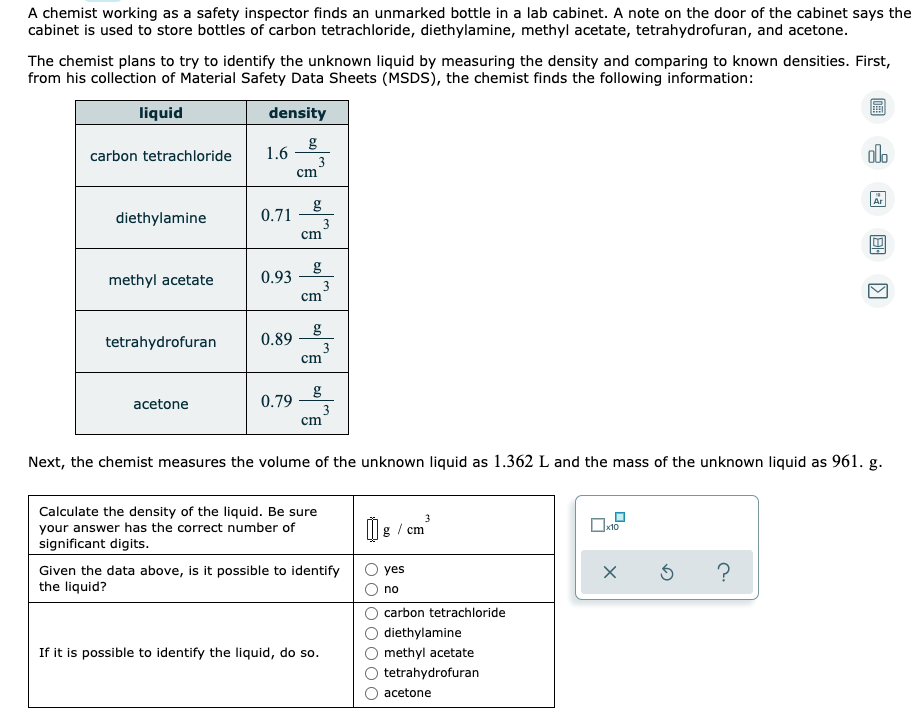A chemist working as a safety inspector finds an unmarked bottle in a lab cabinet. A note on the door of the cabinet says the cabinet is used to store bottles of carbon tetrachloride, diethylamine, methyl acetate, tetrahydrofuran, and acetone. The chemist plans to try to identify the unknown liquid by measuring the density and comparing to known densities. First, from his collection of Material Safety Data Sheets (MSDS), the chemist finds the following information: liquid density carbon tetrachloride 1.6 do 3 cm Ar g 0.71 diethylamine 3 cm methyl acetate 0.93 3 cm g tetrahydrofuran 0.89 3 cm g 0.79 3 cm acetone Next, the chemist measures the volume of the unknown liquid as 1.362 L and the mass of the unknown liquid as 961. g. Calculate the density of the liquid. Be sure your answer has the correct number of significant digits. g/ cm Given the data above, is it possible to identify the liquid? yes no carbon tetrachloride diethylamine If it is possible to identify the liquid, do so. methyl acetate tetrahydrofuran acetone
A chemist working as a safety inspector finds an unmarked bottle in a lab cabinet. A note on the door of the cabinet says the cabinet is used to store bottles of carbon tetrachloride, diethylamine, methyl acetate, tetrahydrofuran, and acetone. The chemist plans to try to identify the unknown liquid by measuring the density and comparing to known densities. First, from his collection of Material Safety Data Sheets (MSDS), the chemist finds the following information: liquid density carbon tetrachloride 1.6 do 3 cm Ar g 0.71 diethylamine 3 cm methyl acetate 0.93 3 cm g tetrahydrofuran 0.89 3 cm g 0.79 3 cm acetone Next, the chemist measures the volume of the unknown liquid as 1.362 L and the mass of the unknown liquid as 961. g. Calculate the density of the liquid. Be sure your answer has the correct number of significant digits. g/ cm Given the data above, is it possible to identify the liquid? yes no carbon tetrachloride diethylamine If it is possible to identify the liquid, do so. methyl acetate tetrahydrofuran acetone
Chemistry
10th Edition
ISBN:9781305957404
Author:Steven S. Zumdahl, Susan A. Zumdahl, Donald J. DeCoste
Publisher:Steven S. Zumdahl, Susan A. Zumdahl, Donald J. DeCoste
Chapter1: Chemical Foundations
Section: Chapter Questions
Problem 1RQ: Define and explain the differences between the following terms. a. law and theory b. theory and...
Related questions
Question
A chemist working as a safety inspector finds an unmarked bottle in a lab cabinet. A note on the door of the cabinet says the cabinet is used to store bottles of carbon tetrachloride, diethylamine, methyl acetate, tetrahydrofuran, and acetone.
The chemist plans to try to identify the unknown liquid by measuring the density and comparing to known densities. First, from his collection of Material Safety Data Sheets (MSDS), the chemist finds the following information:

Transcribed Image Text:A chemist working as a safety inspector finds an unmarked bottle in a lab cabinet. A note on the door of the cabinet says the
cabinet is used to store bottles of carbon tetrachloride, diethylamine, methyl acetate, tetrahydrofuran, and acetone.
The chemist plans to try to identify the unknown liquid by measuring the density and comparing to known densities. First,
from his collection of Material Safety Data Sheets (MSDS), the chemist finds the following information:
liquid
density
g
1.6
3
cm
carbon tetrachloride
olo
Ar
g
0.71
diethylamine
3
cm
methyl acetate
0.93
3
cm
tetrahydrofuran
0.89
3
cm
acetone
0.79
3
cm
Next, the chemist measures the volume of the unknown liquid as 1.362 L and the mass of the unknown liquid as 961. g.
Calculate the density of the liquid. Be sure
your answer has the correct number of
significant digits.
3
cm
Given the data above, is it possible to identify
the liquid?
yes
no
carbon tetrachloride
diethylamine
If it is possible to identify the liquid, do so.
methyl acetate
tetrahydrofuran
acetone
Expert Solution
This question has been solved!
Explore an expertly crafted, step-by-step solution for a thorough understanding of key concepts.
This is a popular solution!
Trending now
This is a popular solution!
Step by step
Solved in 2 steps

Knowledge Booster
Learn more about
Need a deep-dive on the concept behind this application? Look no further. Learn more about this topic, chemistry and related others by exploring similar questions and additional content below.Recommended textbooks for you

Chemistry
Chemistry
ISBN:
9781305957404
Author:
Steven S. Zumdahl, Susan A. Zumdahl, Donald J. DeCoste
Publisher:
Cengage Learning

Chemistry
Chemistry
ISBN:
9781259911156
Author:
Raymond Chang Dr., Jason Overby Professor
Publisher:
McGraw-Hill Education

Principles of Instrumental Analysis
Chemistry
ISBN:
9781305577213
Author:
Douglas A. Skoog, F. James Holler, Stanley R. Crouch
Publisher:
Cengage Learning

Chemistry
Chemistry
ISBN:
9781305957404
Author:
Steven S. Zumdahl, Susan A. Zumdahl, Donald J. DeCoste
Publisher:
Cengage Learning

Chemistry
Chemistry
ISBN:
9781259911156
Author:
Raymond Chang Dr., Jason Overby Professor
Publisher:
McGraw-Hill Education

Principles of Instrumental Analysis
Chemistry
ISBN:
9781305577213
Author:
Douglas A. Skoog, F. James Holler, Stanley R. Crouch
Publisher:
Cengage Learning

Organic Chemistry
Chemistry
ISBN:
9780078021558
Author:
Janice Gorzynski Smith Dr.
Publisher:
McGraw-Hill Education

Chemistry: Principles and Reactions
Chemistry
ISBN:
9781305079373
Author:
William L. Masterton, Cecile N. Hurley
Publisher:
Cengage Learning

Elementary Principles of Chemical Processes, Bind…
Chemistry
ISBN:
9781118431221
Author:
Richard M. Felder, Ronald W. Rousseau, Lisa G. Bullard
Publisher:
WILEY